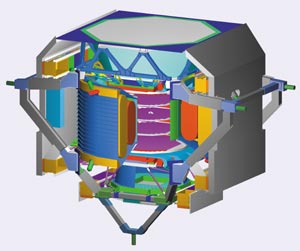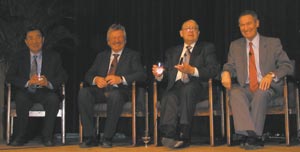Space is the ultimate laboratory for fundamental physics and the possibility of holding experiments there was the theme of the SpacePart ’03 conference. Roberto Battiston reports.

The universe is the largest and richest laboratory at our disposal for studying the laws of nature. In it, matter and energy undergo fundamental interactions and endure extreme conditions for infinitesimal times or for billions of years. Using advanced instruments we are able to select signals that reach us from the depths of space and time, and to extract data on fundamental physics that would not be available even with the most complex experiments performed in our laboratories.
To review the potential of particle and fundamental physics in space, a new series of international conferences, called SpacePart, began in 2002 on the Italian island of Elba. Following the success of SpacePart ’02, which was sponsored by the Istituto Nazionale di Fisica Nucleare (INFN) and the universities of Pisa and Perugia, NASA played host to the 2003 conference on 10-12 December in Washington, DC, jointly with Stanford’s Kavli Institute for Particle Astrophysics and Cosmology, the Massachusetts Institute of Technology (MIT) and INFN. The objective of SpacePart ’03 was to explore the possibilities of doing fundamental physics in space during the next 20 years. The meeting was attended by researchers from a number of diverse subfields of physics and astrophysics – from cosmology and gravitation to elementary particle physics – but all of them had a common interest in space-based experiments.
Coming together
Patrick Looney from the US Office of Science and Technology Policy delivered the opening address, representing the presidential science advisor, Jack Marburger. Looney underlined the importance of bringing agencies and research programmes together, in order to talk about the connectedness of the physical sciences and to show its relevance to the broader quest for discoveries in the universe. Indeed, SpacePart ’03 was a perfect example of this, as all of the US agencies currently active in space science – NASA (Mike Salamon), the Department of Energy (Ray Orbach) and the National Science Foundation (Mike Turner) – presented their programmes. The major European and Japanese agencies also participated, with representatives from ESA (Oliver Jennrich), INFN (Roberto Battiston), ASI (Simona Di Pippo) and ISAS/JAXA (Tadayuki Takahashi).
Frank Wilczek of the Massachusetts Institute of Technology (MIT) gave an inspirational keynote talk, in which he described the universe as a strange place that is characterized by basic numbers – such as the densities of matter, dark matter and dark energy – that we are completely unable to explain. New theoretical ideas are desperately needed to explain dark energy, as the cosmological constant may not be adequate. In addition, Wilczek pointed out that axions might very well be a better candidate for dark matter than the supersymmetric neutralino.

To try to answer these questions, a number of space-borne experiments are being prepared to study the various components of the cosmic radiation. The charged energetic part – cosmic rays – will be measured up to the TeV region with very high accuracy by the magnetic spectrometers PAMELA (in 2005) and AMS-02 (in 2007). Sam Ting of MIT/CERN gave a status report on AMS-02, the first superconducting spectrometer to be operated in space, which will, by the end of the decade, reach an accuracy of one part in a billion in the search for antimatter nuclei.
Jonathan Feng of University College Irvine discussed the perspectives for the indirect detection of dark matter in space-based experiments. He reviewed the various possible scenarios for weakly interacting massive particles (WIMPs): the lightest supersymmetric particle (LSP) based on Bino-Higgsino mixings, Kaluza-Klein dark matter and superWIMP dark matter if the gravitino is the LSP. These models predict a distortion in the spectrum of electrons, positrons and gamma rays, which may be visible with new cosmic-ray experiments such as PAMELA, and in particular with the high statistics expected from AMS-02 and the Gamma Ray Large Area Space Telescope, GLAST.
Hard hitters
The region of extremely energetic cosmic rays, above 1020 eV, will also be actively pursued because of its scientific interest. Angela Olinto of Chicago reviewed the experimental situation regarding these messengers of the extreme universe – particles that carry the energy of a tennis ball served by a top-class player. Even if we do not yet understand where these particles come from and how they reach such huge energies, “Zevatron” (1021 eV) accelerators do seem to exist somewhere in our universe. The advent of the Auger project on the ground, followed at the end of the decade by the Extreme Universe Space Observatory on the International Space Station, will open the way to cosmic-ray astrophysics, as the highest energy particles are so energetic they can traverse vast regions of the universe without significant deflection. Perhaps more exciting, but still more uncertain, would be the possible detection of extremely energetic neutrinos, as discussed by Tom Weiler from Vanderbilt who stressed how significantly the rate predictions are affected by the uncertainty in the neutrino cross-section at these energies.

Neutron stars have been known of for some time now, but we are still not completely sure whether some of them could be made of strange matter instead of neutrons. A fragment of a strange star – a strangelet – would behave like a cosmic ray with an anomalously low charge-to-mass ratio. Jack Sandweiss of Yale reviewed the status of strangelet searches. A strangelet could be detectable in a particle spectrometer such as AMS-02, and indeed one event compatible with the strangelet hypothesis was observed by AMS-01 during the successful 1998 STS91 mission. A strangelet would, however, also have a peculiar interaction with the Earth, giving rise to a unique pattern of “epilinear” seismic signals that would indicate a linear source. Such events have been searched for: in more than a million seismic events recorded in the years 1990-1993, one puzzling event that could be compatible with the passage of a strange-matter nugget through the Earth has been found.
By the light of the Moon
Our pale satellite, the Moon, has been a source of poetical inspiration for thousands of years. It is possibly less well known, however, that since 1969 the Moon has also been a source of high-precision tests of general relativity through reflections of a laser beam from mirrors located on the lunar surface. Advances in detector technology will allow a tenfold gain in sensitivity in these measurements in the coming months. The APOLLO experiment at the 3.5 m telescope at the Apache Point Observatory in New Mexico will perform lunar ranging with millimetre resolution. Each pulse to the Moon will contain 1600 laser photons within a 95 picosecond jitter, of which about one photon will be detected back on Earth with a timing accuracy corresponding to a resolution of about 20 mm. Millimetre sensitivity can be obtained within one minute, a time that should be short enough to beat systematic effects. Among other things, this accuracy would be sufficient to test the weak equivalence principle in the 10-14 region. Next summer, laser ranging from Apache Point will also include tests using the Mercury Orbiter spacecraft, while in future additional improvements in accuracy might come from a laser-ranging experiment on Mars.
A major improvement in sensitivity is expected from a new NASA mission under review, the Laser Astrometric Test of Relativity (LATOR), which was presented at the conference by Slava Turyshev from the Jet Propulsion Laboratory. LATOR will be based on inter-spacecraft laser ranging, and is aiming to improve dramatically the accuracy on the γ factor from about 2 x 10-5 (the already precise result obtained in 2003 using the Cassini spacecraft) to the interesting sensitivity region of 10-8. A test of the LATOR concept is also planned on the International Space Station.

A “cool” subject at SpacePart ’02 had been the cosmic microwave background (CMB). However, with the Wilkinson Microwave Anisotropy Probe now operating and the increase in sensitivity with its successor, PLANK, still awaited, the new hot topic at SpacePart ’03 was CMB polarization. Matias Zaldarriaga of Harvard presented recent data from the DASI instrument, showing that the CMB is weakly polarized. Polarization of the CMB, due to Thomson scattering at the recombination time, links matter density-fluctuations to gravitational wave and lensing effects. Since the power spectrum of cosmological gravitational waves depends on the inflation mechanism, measurements of the CMB polarization should give a glimpse, through the recombination time, into the very early phases of the universe.
Emerging technologies
At the beginning of the next decade the direct detection of gravitational waves by LISA, the three-satellite ESA-NASA interferometer with arms that are five million kilometres long, will open up a new kind of astronomy that is able to see through very dense regions of our galaxy and even behind the recombination shroud. Stefano Vitale of Trento discussed the status of ESA’s LISA pathfinder mission, SMART2, which is planned in 2006 to test basic technological aspects of this ambitious project.
A special session was devoted to emerging technologies that should further improve the physics reach of astroparticle physics in space. Mark Kasevich of Stanford reviewed the prospects for Bose-Einstein interferometry in space, which would allow the construction of ultra-sensitive accelerometers to test gravitational effects to an outstanding level of accuracy. This technology is developing at an incredible pace because of the many applications in the more mundane field of navigation systems and geodesy measurements. Gert Viertel of ETH Zürich presented results from a prototype synchrotron radiation detector flown on the STS108 mission on the space shuttle Endeavour. This detector makes use of the X-ray emission from TeV electrons/positrons interacting with the magnetosphere to measure the flux and charge of these particles in a high-energy window that is not covered by magnetic spectrometers.

Il Park of Ewha Woman’s University in Korea presented a new concept of adaptive optics for a large field of view based on micro-machined movable mirrors, which are capable of following rapidly changing light sources in real time, to monitor for example the emission of an extremely energetic cosmic-ray shower in the atmosphere. Tadayuki Takahashi of ISAS/JAXA also stressed the role of micro and nanotechnologies for future astroparticle-physics experiments in space in building and exploiting cheaper, smaller satellites with a faster turnaround time.
Easier access to space is certainly needed for the growth of this exciting field if it is to attract young talents and exploit new ideas. Indeed, astroparticle physicists have only started to scratch the surface of the potential of space for fundamental physics, and there is still, to paraphrase a well known saying, “plenty of room at the top”. SpacePart ’04 is to be held in Beijing at the end of 2004 and will be sponsored by the Chinese Ministry of Science and Technology. See you there!





